Since my syndicated newspaper column launched in 2008, I receive up to 1,000 emails a week asking coupon-related questions! I’m always happy to answer questions from people learning to coupon.
But many of the questions are asked frequently… hence, this Frequently Asked Questions :) If you’re new to couponing, chances are, the answer to your question may be here…
- Where can I get high-value coupons ($1 or more?)
- Where can I get multiples of the same coupon?
- How do I know what kinds of coupons my store will accept?
- What’s the difference between store and manufacturer coupons?
- How do I load electronic coupons to my store card?
- How do I get things free with coupons?
- Can you show me an example of coupon stacking?
- Can you show me an example of coupon stacking with electronic coupons?
- Can you show me an example of coupon overage with stacking?
- How do I organize my coupons with the “clipless” system?
- Don’t all coupons expire in about a month? Is it worth saving them?
- Won’t I just save the same amount of money if I buy store brands, or if I shop at a supercenter?
- We eat healthier foods and organics. Are there coupons for these?
- Is it fraudulent to use expired coupons?
- Our stores don’t double coupons. Can I still save big?
- Why wouldn’t a store accept internet coupons?
- How can I avoid spam when registering to print coupons?
- How do I know when an item is at its lowest price in the 12-week cycle?
- How long does it take you to plan your shopping trip each week?
- Can I see some of your receipts?
- Is your Super-Couponing class available on DVD?
Where can I get high-value coupons ($1 or more?)
If you live in an area where multiple newspapers are available, you may have noticed that different newspapers have different coupons in the inserts — even though the names (Redplum, SmartSource, etc.) are the same. In many areas, advertisers may insert more coupons in the largest newspaper serving that market area. And, often, the coupons in the larger paper are higher-value – $1 or more.
People often ask how many newspapers I get. I do get my local newspaper for my local news, but on Sundays I also get the Chicago Tribune, as it has different coupons than my local paper. It’s a small investment to get more and possibly higher-value coupons.
Be aware too that depending on where you live, that larger paper may actually be published in another state. Many Northern Indiana and Southern Wisconsin coupon shoppers are picking up the Chicago Tribune for the coupons, even though it’s an Illinois paper. (It’s still available on the newsstand or via home delivery in those areas – but be open to the idea that the larger paper may be out-of-state if you’re near a state line.)
One easy way to know which paper has the most? Visit your library on Sunday and check out the coupon inserts for ALL the papers delivered in your area, and compare them. Or invest a few dollars and buy copies of ALL of your local newspapers on the same day the coupons come out (typically Sunday.) It will quickly be evident which paper(s) have the most coupons in them — and look on the bright side — you’ll have multiple coupon inserts from this “experiment” too.
Additionally, many printable coupons are high-value as well. Visit the Coupon Tools link at the top of this page, or visit individual manufacturer sites (Where to find coupons) where you can print higher-value coupons too.
The coupon magazine All You is literally filled with high-value coupons each month too. Each issue typically has $20-$50 worth of coupons inside! All You sells for $2.49 at Wal-Mart or you can subscribe online for less.
And don’t overlook the value of contacting your favorite companies and praising their products! For a few minutes’ time, emailing the manufacturers of products you like often results in an envelope of high-value coupons arriving at your mailbox a few days later. Here’s a list of sites to get you started.
Where can I get multiples of the same coupon?
Especially when you’re new to couponing, it definitely helps to have multiples when we hit a good sale and want to stock up! If you are currently receiving one newspaper with coupon inserts, consider getting two (or more.) In many areas, a second Sunday paper may cost as little as .50/week. Consider that the P&G insert alone usually has around $70 coupons in it the week it appears… it may be worth it to you to pay .50 more to get another $70 worth of coupons.
Some newspapers will deliver double inserts if requested. Other coupon shoppers make friends with their newspaper carrier and ask for the extra papers after Sunday’s delivery is done. Still others visit local coffeehouses or restaurants on Sunday after the morning rush… and offer to “clean up” all those newspapers for them, taking home many extra inserts too. Get creative!
Remember to get coupon inserts from people that might not be using them too — family, friends, or anyone! The more coupons, the better.
Printable internet coupons are another great source of multiples. Most have a print limit of two, but some have higher print limits. I always try to print until I receive the message “Your print limit has been reached.” And, if you have access to multiple computers, you can of course print more. Remember NEVER to make photocopies of internet coupons — this is coupon fraud, and you can easily be caught, because the coupons contain a code referencing your computer’s IP address.
The store itself is another source. Keep your eyes open for tearpads and coupon dispensers in the aisles. I always “cruise” the coupons in the store and take some in anticipation of the next sale. This is another great way to get several coupons for items and brands you buy frequently.
Consider, too, that the method I teach and use is to save the entire coupon insert (the “clipless” system!) Many coupons repeat frequently, and it’s not uncommon for coupons for things like cereal, juice and snacks to repeat over several weeks or months… and the coupons from those previous inserts may still be current and unexpired. When that item finally goes on sale at a good price, with all of the combined inserts, we may have half a dozen or more coupons for the same item, just by saving them all.
How do I know what kinds of coupons my store will accept?
Every store has a coupon policy which details exactly what kinds of coupons the store will take — whether they accept internet coupons, whether you can stack, whether they will double coupons or accept competitor’s coupons. Check your store’s website or email them for a copy.
The most-often-heard complaint I hear from readers is that a store is refusing to accept internet coupons — and in most cases, the store’s corporate policy IS to accept them. In this case, print and carry a copy of that policy with you in case you are confronted with this issue again. I have some coupon policies posted here too.
What’s the difference between store and manufacturer coupons?
Manufacturer coupons will always have the wording “Manufacturer Coupon” somewhere on the coupon. Even if a coupon has a store’s name or logo on it, if it has the words “Manufacturer Coupon” on it, it’s a manufacturer coupon. Store coupons typically say “Store Coupon” or “Retailer Coupon” on the top, and they will have a store’s name or logo on them as well. This difference is, of course, important to us because of coupon stacking. Many stores allow us to stack store and manufacturer coupons together for additional savings.
How do I load electronic coupons to my store card?
It’s easy! Visit your store’s website or one of many national coupon sites to get started. I’ve got an entire overview of using electronic coupons here.
How do I get things free with coupons?
Anytime we can match a low sale price with a high-value coupon, we’re taking things home at a maximum savings — which often is totally FREE! Here’s an example:
In this ad, Cocoa Krispies cereal is on sale for .99. And with a $1.00 coupon… it’s FREE.
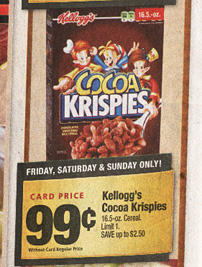
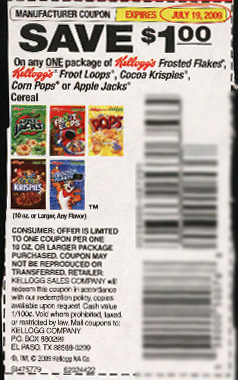
Can you show me an example of coupon stacking?
Sure! When we stack coupons, we use one STORE coupon and one MANUFACTURER coupon together on the same item, which many stores allow. This is an example from Meijer…
Meijer has Kraft Mayonnaise on sale for $2. I printed a $1 manufactuer coupon from Kraft’s website, and I also printed a $1 store coupon from Meijer’s Mealbox printable coupons:
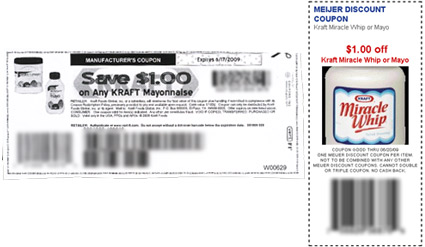
$1 manufacturer coupon + $1 store coupon = $2 coupon value… = FREE mayonnaise.
Can you show me an example of coupon stacking with electronic coupons?
Absolutely! This is an example from Jewel…
Jewel has Skintimate shaving gel and cream on sale for $2.49. On my electronic coupons for Jewel, I have .60 off Skintimate, and I also have a $1.50 manufacturer coupon for the Skintimate:
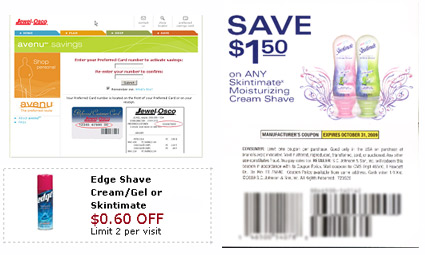
Stacking these discounts together gives me $2.10 savings, making the Skintimate just .39!
Can you show me an example of coupon overage with stacking?
Overage deals are some of my favorites, because when the value of our coupons exceeds the cost of the item we’re buying, in many cases the store actually ends up “paying” us to take the item home. The store won’t give you cash back, but the extra money is applied to everything else you’re buying that day. Overage is a privilege, not a right… but it’s a wonderful way to bring your bill down.
This is an example from Target. Degree men’s deodorant is on sale for $2.19.
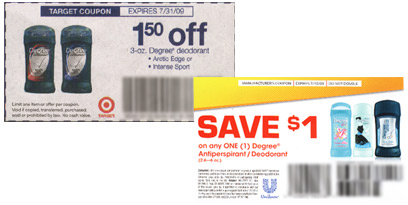
With a $1.50 Target store coupon and a $1 manufacturer coupon stacked together, I have $2.50 in coupon value on a $2.19 item. I get the deodorant free, plus I have gained .31 in overage.
How do I organize my coupons with your “clipless” system?
I love the “clipless” system because it’s designed to do just that… CLIP LESS! Instead of cutting out every coupon from the weekly newspaper inserts, we save the entire insert, intact, then only cut and carry what we actually need this week. Learn more here on my Super-Couponing site, with illustrated descriptions of how to organize and carry coupons with this method.
Don’t all coupons expire in about a month? Is it worth saving them?
It’s really a myth that “all coupons expire” within 1-2 months of when you get them. Take a look at this link. It’s a list of all the past newspaper inserts’ dates that still have current, unexpired coupons in them. There are typically inserts dating back six months or more with current, unexpired coupons in them. That’s much longer than the 1-2 months people assume most coupons expire within. This is also the reason I strongly advocate keeping the entire coupon insert intact each week, because we can truly build a library of them when they have longer expiration dates and use that additional time to match them to sales. I get most of my best discounts this way!
Won’t I just save the same amount of money if I buy store brands, or if I shop at a supercenter?
Not at all. With rare exception, there typically aren’t a lot of coupons out for store-brand products, and if you learn to match coupons to rock-bottom priced sales, when the price of an item is hitting its lowest point in the sales cycles, you will be taking name-brand items home much cheaper than you can buy store brand products. Store brand products typically don’t cycle high/low the way name brand products do.
Will you get receipts like these buying the store brand? Often, with coupons, I’m getting the name-brand item totally free, just by matching the coupon to the best sale. If you look at any of my receipts, very few of the items I buy are store brand — and if I am buying a store brand, it’s because I usually also have a coupon for that item. Store-brand coupons do pop up on occasion, whether in the store’s flyer, on their website, or even in the store itself, and if you DO find coupons for store brands, they absolutely can be a good buy too. Coupons totally level the playing field!
As far as the “supercenter argument,” again, the prices we pay at the supermarket will take larger dips in price than the “everyday low prices” of a supercenter. Read more on this here for some examples – I compared a supercenter to a supermarket during the same week and recorded prices on both. The results will likely surprise you more than you expect!
We eat healthier foods and organics. Are there coupons for these?
Our family eats healthy with coupons — no HFCS or artificial sweeteners, and organics whenever we can. There are lots of coupons out for organics:
Cascadian Farms
Earthbound Farm
Eat Better America
Horizon
Kashi
Mambo Sprouts
Naturally Savvy
Organic Valley
Stonyfield Farm
Wild Harvest
Sign up for the Organic Valley, Mambo Sprouts and any other newsletters that you like – they mail out books of high-value coupons at least 4 times a year.
There are definitely coupons for healthier foods too — you just have to watch your deals and stock up when good things come along. Look at some of the prices I paid after coupons on healthier foods, produce and organics during a recent sale at a major supermarket.
Look for printables too – many organic lines often have printable coupons. (Locally, Wild Harvest frequently has $1 off “any Wild Harvest product” at www.wildharvestorganic.com – and these can be applied to any fresh, organic produce in the Wild Harvest section of our grocery store. I’ve bought carrots and cucumbers with these before (and gotten them free!) There are a lot of coupons for organic milk too. Last summer I hit a deal on organic milk where I was paying .75/half gallon for Stonyfield Farm milk after coupons.
And… I would bet that no matter what your eating habits, you still use toothbrushes, shampoo, razors, soap, toothpaste and other personal care products… which are cheap/free often with coupons. :) There are also lots of coupons for cleaning products, paper products, and other non-food items every household uses.
Is it fraudulent to use expired coupons?
If a store’s policy states that they don’t accept expired coupons, I definitely would not use them there. But check your store(s) policies — some stores actually do accept them. Typically, the stores that accept them may take them from 30-90 days back, because that may correspond with the window of time that particular store uses to redeem the coupons for cash. If you’re passing expired coupons though at a store that does not accept them, you have to equate it as “stealing” from the store — you’re using a coupon to “pay” for something that your store will never see the money for. If you wouldn’t shoplift from a store, you shouldn’t use an expired coupon either. It’s wrong, and it also gives us a bad name as coupon shoppers if we look like we’re trying to “beat the system.” We’re not — there’s PLENTY of money to be saved legitimately with unexpired coupons too.
Our stores don’t double coupons. Can I still save big?
Absolutely. Our stores in Chicago don’t double coupons either, and we do very well with our coupons. You definitely don’t have to shop at a store that doubles to get great savings. Another thing to note is that some stores in areas that don’t double DO accept expired coupons, either for a few months expired, or indefinitely. They may do this in lieu of not doubling.
Also, keep an eye on Kmart though if you have any in your area — they run great double coupon promotions periodically where they double up to and including $2 coupons. These are great stock-up opportunities. At our last double coupon sale at Kmart, I bought $74 worth of items for $5 and change! :)
Why wouldn’t a store accept internet coupons?
Internet coupons have come a long way. When they first arrived on the scene, there were very few security measures in place to either limit how many coupons one could print, or track the prints available in a coupon campaign. But internet coupons are safe, reliable, and often high-value! The store will be reimbursed for an internet coupon, just as they will from a coupon that appears in the newspaper inserts.
The biggest issue with internet coupons is coupon fraud — some people will print a coupon, then xerox it and use multiple copies. Because each internet printable has a unique bar code or print identifier, when these coupons are reimbursed, the store is only reimbursed for ONE of the unique prints, and not the copies. If a store has encountered rampant abuse or fraud, they may stop accepting internet coupons.
Finally, check to see what your store’s corporate policy is on internet printable coupon acceptance. Many stores have their coupon policies online, and a store’s coupon policy will specify whether the store takes printable coupons or not. These are very important tools for shoppers, as you just might learn that it IS corporate’s policy to accept internet coupons, even if you’ve been told no at the store (for some reason, the #1 store I hear complaints about not accepting printables is Wal-Mart, but Wal-Mart indeed does accept them, as their policy states on their own website.) At that point, print a copy of the policy and carry it with you. You just may find yourself in the unusual position of knowing the store’s coupon policy better than the cashier does.
How can I avoid spam when registering to print coupons?
There’s a reason I like Coupons.com, RedPlum.com, SmartSource.com and CouponNetwork.com – NONE of these sites require you to register to print coupons :) But if you are on a manufacturer’s site that does require registration, use a free email account, like Yahoo Mail. I have a separate “coupon” account just for this purpose.
How do I know when an item is at its lowest price in the 12-week cycle?
As shoppers, buying the things we need when the price hits its 12-week low saves us the most money, especially when we use our coupons to bring the price down even more. Typically, a product is at its 12-week low when the sale price is 50% less (or better!) than the non-sale (shelf) price of the item. If a price drops to half of what it usually is, or less, it’s a buy! Sites like www.savingsangel.com, www.couponmom.com and www.grocerygame.com help track the sales for you and let you know when an item is hitting the 12-week low.
Also, after a while, you will just start to “learn” what good prices are for the items you buy frequently. Typically, it takes 12 weeks for you to go through the cycle and start to notice the highs and lows for everything you buy. Remember too that every item is on its own, independent 12 week cycle. If cereal is low this week, pasta could be high, and so on. Each product and product category cycles independently of the others.
How long does it take you to plan your shopping trip each week?
Probably not as long as you think! I currently spend about a half-hour to an hour a week planning and clipping. But in that half-hour, I’m saving, on average, $100 a week with coupons. (Really!) The key to cutting down the time spent in this is using the “clipless” system to organize coupons, so we’re only cutting what we need, and using one of the national websites matching coupons to sales for our local stores. When you can log into a site and get a list of everything that’s on sale in your store and which coupons to use with it, it’s simply a matter of clicking the items you want to buy this week, going to your coupons, cutting the ones you need, and going to the store.
Sites that match grocery stores’ sales to coupons:
You can also use a Coupon Lookup to find specific coupons in your inserts for items you need or want to purchase.
You can learn more about trip planning here.
Can I see some of your receipts?
Sure! Here are a few:
- A $154.69 bill down to $49.69 after coupons
- A $125.96 bill down to $22.41 after coupons
- A $94.03 bill down to $6.58 after coupons
- A $55.91 bill down to $2.95 after coupons
- A $77.69 bill down to $1.41 after coupons
- A $34.38 bill down to $0.68 after coupons
Here are some examples where the stores actually paid me to take my groceries home:
- A $98.09 bill down to $8.63 after coupons
(this receipt was from my Fox News shopping trip, so you can even watch and see what I bought! It generated a Catalina coupon for $10 worth of free food for my next shopping trip, so the store essentially paid me $1.37 to take all of this home!) - An $83.99 bill down to $2.87 after coupons
(this receipt also generated a Catalina coupon for $10 worth of free food for my next shopping trip, so the store essentially paid me $7.13.) - A $44.39 bill down to $1.94 after coupons
(this receipt also generated a Catalina coupon for $10 worth of free food for my next shopping trip, so the store essentially paid me $8.06.)
Is your Super-Couponing class available on DVD?
YES! Visit www.supercouponing.com to order, or click below for a preview…










sweetpachy says
I have been couponing for years. When I get a coupon that is buy one get one free. I frequently have a coupon for the one that I have to buy, so I use both. I have only had trouble at one store with one checker. My question is this, Is that something that is considered “legal”?
Eunice Wall
emw@att.net
gordanaer says
Hi,
I like to shop at Ultra Food store…I noticed that you are not posting any deals for that store. Is there a reason?
thank you
Jo_Shoemaker says
I live in the Indianapolis (IN) area and receive the Indianapolis Star (Thursday & Sunday editions). The main stores in my town are Super Wal-Mart and Kroger. I also have a Meijer and Super Target. I recently “herd” that my local) Kroger will only DOUBLE the FIRST coupon for a particular item. Is there a way around this or is the only way to do it is to seperate my purchases into seperate transactions? I read the Kroger policy and it did NOT say that only the first coupon will be doubled. So, with there being conflicting information do you know how to proceed when using multiple coupons when purchasing multiples of a particular item”?
When I have looked at various store websites, it is almost impossible to find their coupon policies…is there a “trick” on finding the policy?
As a newbie to extreme couponing I have hundreds of questions and am spending as much time as I have reading and researching as many websites as I can. If you can help me understan how this works, I would be incredibly thankful.
avennger17 says
Is Savings Angel worth the $5 or is there a better site?
Thanks!!
meena1515 says
I found a weekly coupon booklet that has coupons but in spanish. Can i use these spanish coupons in a non spanish store? Like Target or Walmart? Or can i only use them in spanish supermarkets? . . .